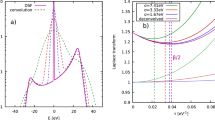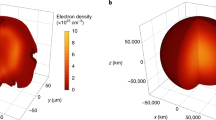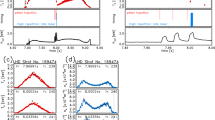Abstract
THE measurement of electron temperature in hightemperature plasmas is an important but somewhat difficult problem particularly for temperatures above about 10 eV. Spectroscopic methods which have been used or suggested1–4 are subject to certain limitations and have been reviewed by Thonemann5. This communication presents a new method, based on the relative intensities of spectral lines from the same species of Li-like ion, which is potentially powerful in its range and accuracy.
This is a preview of subscription content, access via your institution
Access options
Subscribe to this journal
Receive 51 print issues and online access
$199.00 per year
only $3.90 per issue
Buy this article
- Purchase on Springer Link
- Instant access to full article PDF
Prices may be subject to local taxes which are calculated during checkout
Similar content being viewed by others
References
Jahoda, F. C., Little, E. M., Quinn, W. E., Sawyer, G. A., and Stratton, T. F., Phys. Rev., 119, 843 (1960).
McWhirter, R. W. P., Bull. Amer. Phys. Soc., 8, 164 (1963).
Cunningham, S. P., U.S. Atomic Energy Comm. Rep. WASH-289 (1955).
Williams, R. V., and Kaufman, S., Proc. Phys. Soc., 75, 329 (1960).
Thonemann, P. C., Optical Spectrometric Measurements of High Temperatures, ed. by Dickerman, W., 56 (University of Chicago Press, Chicago, 1961).
Wilson, R., J. Quant. Spec. Rad. Trans., 2, 477 (1962).
Seaton, M. J., Atomic and Molecular Processes, edit. by Bates, D. R., 374 (Academic Press, New York, 1962).
Bates, D. R., and Damgaard, W., Phil. Trans. Roy. Soc., A, 242, 10 (1942).
Allen, C. W., Astrophysical Quantities, second ed., 43 (Athlone Press, London, 1963).
Butt, E. P., Carruthers, R., Mitchell, J. T. D., Pease, R. S., Thonemann, P. C., Bird, M. A., Blears, J., and Hartill, E. R., Proc. Second Intern. Conf. Peaceful Uses of Atomic Energy, Geneva, 32, 42 (United Nations, Geneva, 1958).
Hinteregger, H. E., Damon, K. R., Heroux, L., and Hall, L. A., Space Research I, edit. by Kallman Bijl, H. K., 615 (North Holland Pub. Co., Amsterdam, 1960).
Hinteregger, H. E., Space Astrophysics, edit. by Liller, W., 34 (McGraw-Hill, New York, 1961).
Griffin, W. G., and McWhirter, R. W. P., Proc. Conf. Optical Instruments and Techniques, edit. by Habell, K. J., 14 (Chapman and Hall, Ltd., London, 1962).
Burton, W. M., and Wilson, R., Proc. Phys. Soc., 78, 1416 (1961).
Burton, W. M., Butt, E. P., Cole, H. C., Gibson, A., Mason, D. W., Pease, R. S., Whiteman, K., and Wilson, R., I.A.E.A. Conf. Plasma Physics and Controlled Nuclear Fusion Res., Salzburg, CN-10/60 (1961).
Author information
Authors and Affiliations
Rights and permissions
About this article
Cite this article
HEROUX, L. A Spectroscopic Method of measuring Electron Temperatures in Plasmas. Nature 198, 1291–1293 (1963). https://doi.org/10.1038/1981291c0
Issue Date:
DOI: https://doi.org/10.1038/1981291c0
This article is cited by
Comments
By submitting a comment you agree to abide by our Terms and Community Guidelines. If you find something abusive or that does not comply with our terms or guidelines please flag it as inappropriate.



